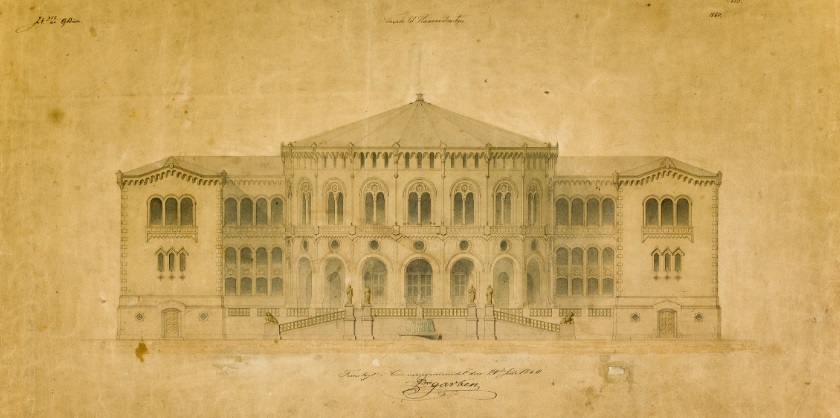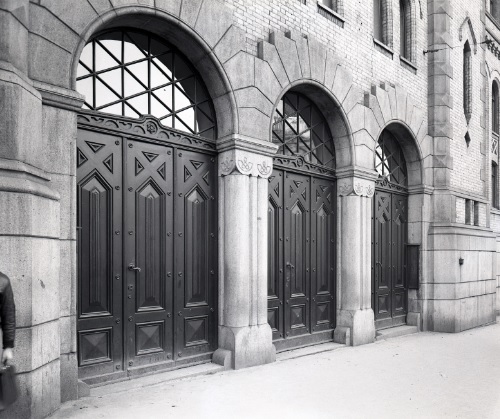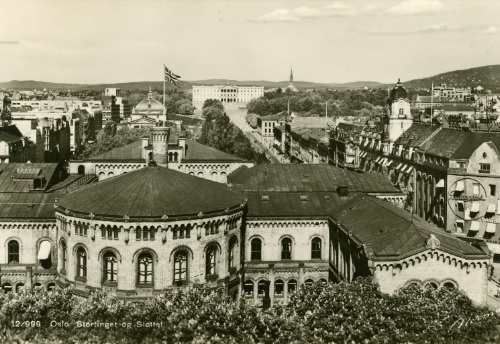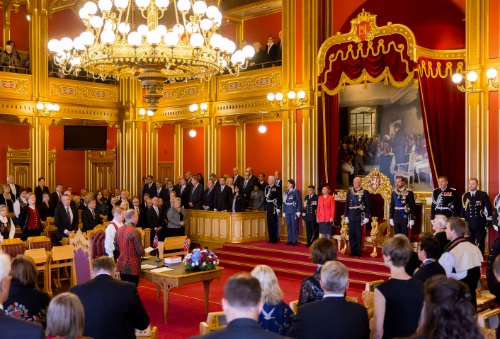
The Storting building’s facade by Emil V. Langlet, 1860. Directorate for Cultural Heritage. Photo: National Archives, 2015.
The Storting building’s 150th anniversary
The Storting building, one of Norway’s most unmistakable buildings, and the country’s most important symbol of democracy, is celebrating its 150th anniversary in 2016.

The three entrance doors on Karl Johans gate, ca. 1950. Langlet, the architect, was intent on making the Storting building accessible to the population. The stairs to the Storting Chamber’s public gallery start from just inside one of these elegant doors. Photo: Storting.
Watch film about the Parliament building's history and design.
When the Storting building was completed in 1866, it was unique and innovative. It didn’t look quite like other parliaments; a relatively small building, yet one with a character all of its own. Rather than towering grandly above the people, it joined them at street level, comfortable among the city populace. The Storting Chamber, its circular form clearly visible to the outside world, provided the population with a tantalising glimpse of the democratic debate taking place inside. The front of the Storting was an example of how a parliament ought to appear and be: open and accessible, with windows looking out on the electorate, and nine equal entrance doors to invite the public in.
Today the Storting is among Norway’s most characteristic buildings. Located in the middle of Karl Johans gate, the capital city’s main street, it has become an integral part of the urban landscape. Yet the fact that the Storting is sited where it is, and the fact that it looks like it does, was hardly a foregone conclusion. The building’s completion in 1866 was the culmination of several decades of vehement debate about location and design. An architectural competition was arranged, and the original winning entry was a towering neo-Gothic structure. This was never built.

The siting of the Storting building created a new axis in the capital city, with the Royal Palace and the Storting building facing one another from their respective vantage points, and with the University between. Photo: Storting.
Instead, the Storting adopted the proposal of a young Swedish architect called Emil Victor Langlet. His solution was unusual and received a mixed reception. Yet for the majority, the building’s distinctiveness was a selling point. This was not simply an imitation of other national parliaments or monumental structures. Rather, it was a modern building that reflected the values of Norwegian democracy – open, moderate and in harmony with the people. Its placement, facing the Royal Palace and with the University between, was a defining moment in Oslo’s urban development. In 1861, almost half a century after Norway’s Constitution was adopted, the foundation stone of a new Storting building was finally laid.
With the completion of the building, democratic development in Norway gathered pace. The Members of Parliament finally had somewhere specifically designed for their political activities. With a place of its own, the Storting could convene annual sessions. Parliamentary rule was born, political parties were formed, and politics was professionalized. The Storting reinforced its position. Modern Norway began to take shape.
After only a few decades, however, it became clear that Langlet’s Storting was too small. A new architectural competition was announced in 1949, and once again the building became the centre of intense debate. Would it be possible to reconcile tradition and progress in Langlet’s building? Should an extension be added? Or should one simply demolish the existing structure and start again from scratch? Numerous solutions were put forward, but the jury eventually agreed to architect Nils Holter’s proposal. In August 1951 a major reconstruction of Langlet’s building was set in motion.
When celebrating the 150th anniversary of the Storting building, we are also toasting the successful union of two architects and two epochs. “The new has entered into a joyful union with the old,” as President of the Storting Nils Langhelle so aptly put it in 1959.
The Storting building came into being on the back of considerable public debate and competition, and its appearance and location have been major contributors to shaping our capital city. Questions about the building’s function and significance have long since disappeared.

There is activity in the Storting all year round. This is from the Main Chamber during the State Opening of the Storting on 2nd October 2015. Photo: Storting.
Today the Storting houses a broad range of occupations and activities. Yet the primary responsibility of everyone who works here is to make sure that the elected Members of Parliament are best able to perform their most important duties: to pass Norwegian laws, allocate money in the Fiscal Budget and supervise the work of the Government.
The Storting is a hive of activity all year round. Just outside the building, in Eidsvolls plass, the voice of the people comes to the fore through rallies and demonstrations. When they look out of the Storting Chamber’s windows, the Members of Parliament can see the life of their capital city unfolding before them, the thousands of people coming and going along Karl Johan. Likewise, from Oslo’s most famous street, one can look up at the Storting Chamber; the arena for many of the nation’s most critical moments; a room that itself is the very symbol of Norwegian democracy.
What they say about the Storting building.
Jubilee activities in 2016
The Storting is a building that richly deserves to be celebrated. 2016 will play host to a wide variety of jubilee events and initiatives, including exhibitions, seminars and city walks. And on 9th May the Storting has invited children to a very special outdoor jubilee party. Invitations have already been sent to all 5th year school classes in Oslo and Akershus. That same afternoon, the Storting will also be opening its doors to the public.
Celebration in the Storting on Thursday 3rd March
The opening event of the 2016 jubilee took place on Thursday 3rd March.
More about the marking of the Storting building’s 150th anniversary on 3rd March.
New jubilee book and film about the Storting building
A new book about the Storting building, written by the architect Peter Butenschøn, was launched on Thursday 3rd March. A film about the history of the building was also given its premiere. Both the book and film will also be available in English.
More information about Peter Butenschøn’s book.
A link to the film will be available later.
Exhibition in the National Museum of Art, Architecture and Design
The National Museum of Art, Architecture and Design will be putting on a special jubilee exhibition to mark the anniversary of the Storting building. The museum will be displaying original drawings and models connected to the process leading up to the building of the Storting in 1866. The anthology Debatten om stortingsbygningen 1836–1866 (“The debate about the Storting building 1836-1866”), edited by Mari Hvattum, will be launched at the opening of the exhibition on 12th March. More about the National Museum's exhibition.
Last updated: 02.03.2016 14:27